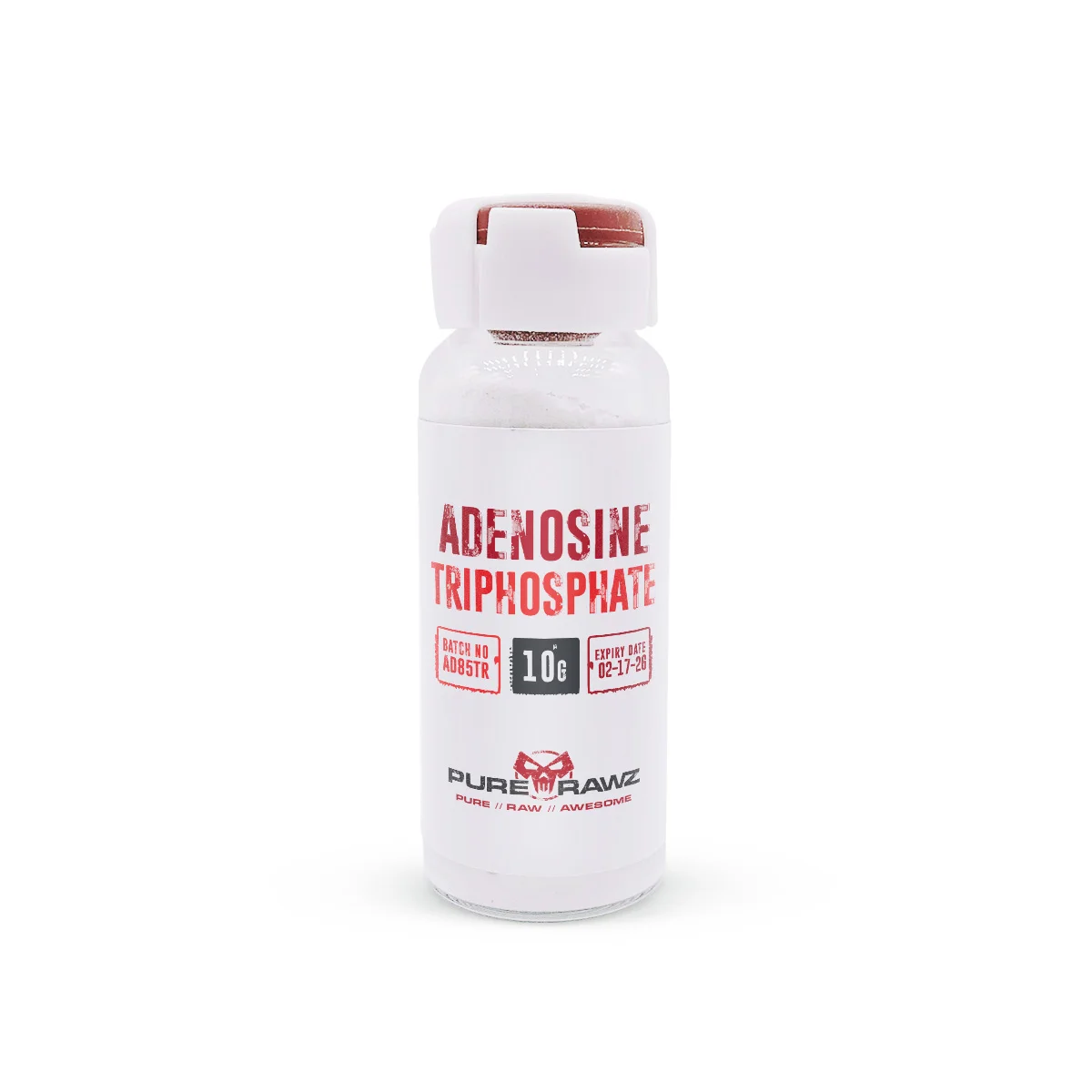Adenosine Triphosphate
Price range: $29.71 through $184.23
Earn 30 - 184 points upon purchasing this product.
- 1st and 3rd Party Verified for 99% Purity
- Free Shipping on Orders Over $100+
Enjoy 24/7 customer support, 1st & 3rd party verified 99% purity, and free shipping on orders over $100!
Description
Adenosine Triphosphate – Product Information
ATP plays a pivotal role in facilitating numerous cellular functions, including cell division and biosynthetic reactions. During cell division, ATP provides the necessary energy to drive the intricate process of DNA replication and chromosome segregation. It ensures the accurate duplication of genetic material, vital for the growth and repair of tissues.
Furthermore, ATP is indispensable for biosynthetic reactions within the cell. These reactions involve the construction of complex molecules required for various cellular functions, such as the synthesis of proteins, nucleic acids, and lipids. ATP’s energy-rich triphosphate group acts as a molecular fuel, enabling these biosynthetic processes to occur efficiently. Commercially produced ATP, for the purpose of research, may come in powder or tablet form.
Disclaimer: This product description is intended solely for informational purposes and does not constitute a promotion or endorsement of any specific ATP-related product. As a potential customer, you may review this content as you decide to use our product for research purposes.
| Adenosine Triphosphate | |
| CAS Number | 987-65-5 |
| Molar Mass | 128.3 g/mol |
| Chemical Formula | S4 |
| IUPAC Name | [[(2R,3S,4R,5R)-5-(6-aminopurin-9-yl)-3,4-dihydroxyoxolan-2-yl]methoxy-hydroxyphosphoryl] phosphono hydrogen phosphate |
What is Adenosine Triphosphate?
Adenosine Triphosphate (ATP) is a vital molecule within living organisms. Its relatively small molecular weight, despite its crucial role, allows it to efficiently participate in many cellular processes. ATP serves as an energy currency within cells, providing the necessary fuel for various cellular activities, motility, respiration, biosynthetic reactions, and cell division. When ATP undergoes hydrolysis, it releases energy and transforms into Adenosine Diphosphate (ADP), thereby resulting in a decreased quantity of available ATP.
This energy transfer from ATP to ADP powers a multitude of cellular processes, enabling organisms to carry out essential functions such as muscle contractions, active transport, and biosynthesis. In essence, ATP is the molecular powerhouse that drives a multitude of cellular processes by supplying energy in a highly efficient manner.
Possible Applications of Adenosine Triphosphate for Sale
Intracellular Signaling
ATP plays a vital role in signal transduction within cells. It acts as a substrate for kinases, proteins that are abundant in cells and are crucial for phosphorylating other proteins. This phosphorylation sets off a chain reaction, activating various intracellular signaling pathways. Laboratory research has shown that ATP is a key player in initiating these signaling cascades. [R]
The presence of magnesium ions helps regulate kinase activity, ensuring that these signaling processes are finely controlled. These ions form complexes with ATP within cells, which further modulate kinase function. Clinical studies have investigated the role of magnesium ions in maintaining kinase activity and intracellular signaling. [R]
ATP also serves as a trigger for the release of various intracellular messengers, such as hormones, enzymes, and growth factors. These messengers play critical roles in cellular communication. Research has demonstrated ATP’s involvement in the release of these messengers, particularly in G-protein coupled receptor signaling pathways. [R]
Neurotransmission
ATP could be an important link to the brain’s neurotransmission. The brain, which consumes a significant amount of ATP, relies on it to maintain ion concentrations for proper neuronal signaling and synaptic transmission. Laboratory research has detailed the energy-intensive process of synaptic transmission, including the role of ATP in establishing ion gradients, vesicle priming, and active transport to reset ion concentrations. [R]
ATP is crucial for the propagation of action potentials along axons. Research has shown that approximately one billion ATP molecules are hydrolyzed for each action potential to restore sodium and potassium ion concentrations, enabling signal transmission. [R]
In excitatory synapses, ATP is essential for the release and recycling of vesicles containing glutamate, a neurotransmitter. This process requires a significant amount of ATP due to the large number of glutamate molecules stored in each vesicle. Studies have investigated the energetic demands of glutamatergic synapses. [R]
DNA/RNA Synthesis
ATP is essential for the synthesis of DNA and RNA. In RNA synthesis, ATP is one of the four nucleotide-triphosphate monomers required. A similar process occurs in DNA synthesis, where ATP is transformed into deoxyribonucleotide, known as dATP. Clinical studies have explored the importance of ATP in nucleotide synthesis for genetic material formation. [R]
Purinergic Signaling
Purinergic signaling, mediated by purine nucleotides like ATP, involves the activation of purinergic receptors on nearby cells, regulating intracellular processes. Laboratory research has elucidated the role of ATP release and its regulation in purinergic signaling, impacting autonomic functions, neural interactions, and more. [R]
ATP in Muscle Contraction
Muscle contraction, a fundamental physiological process, relies on ATP for three primary functions: generating force against actin filaments, pumping calcium ions across the sarcoplasmic reticulum, and transporting sodium and potassium ions across the sarcolemma. Research has demonstrated how ATP hydrolysis powers these essential processes in muscle contraction. [R]
How Does Adenosine Triphosphate Work?
The human body employs various processes to generate ATP, the energy currency of cells, depending on the current metabolic conditions. ATP production can take place both in the presence of oxygen, through cellular respiration, as well as in anaerobic conditions.
Cellular Respiration
Cellular respiration involves breaking down glucose into acetyl-CoA, leading to the production of high-energy electron carriers that eventually yield ATP. Initially, during glycolysis, glucose splits into two pyruvate molecules, accompanied by the generation of two ATP molecules and two reduced NADH electron carriers. Pyruvate is then converted into acetyl-CoA, which undergoes complete oxidation in the citric acid cycle. This cycle results in the production of carbon dioxide, one ATP equivalent, three NADH molecules, and one FADH2 molecule. These high-energy electron carriers transfer their electrons to the electron transport chain, where ATP is synthesized as protons move across the mitochondrial membrane. The quantity of ATP generated varies depending on the electron carrier involved, with one NADH yielding two and a half ATP and one FADH2 producing one and a half ATP.
Beta-Oxidation
Beta-oxidation is an additional mechanism for ATP synthesis, primarily involving the breakdown of fatty acids to produce acetyl-CoA molecules. Each cycle of beta-oxidation shortens the fatty acid chain by two carbon units, generating one acetyl-CoA molecule along with one NADH and one FADH2 molecule, which contribute to ATP production.
Ketosis
Ketosis is a metabolic process that produces ATP by breaking down ketone bodies. This process generates twenty-two ATP molecules and two GTP molecules for every acetoacetate molecule oxidized within the mitochondria.
Anaerobic Respiration
In situations where oxygen is scarce or unavailable for cellular respiration, cells resort to anaerobic respiration. During anaerobic conditions, a surplus of NADH accumulates because it cannot be oxidized to NAD+. This limitation affects GAPDH and glucose consumption. To maintain balanced NADH levels, pyruvate is reduced to lactate through lactic fermentation. This process allows for the oxidation of one NADH molecule and produces only two ATP molecules for every glucose molecule.
These diverse processes, driven by metabolic conditions, play crucial roles in the body’s ability to generate ATP, providing the necessary energy for various cellular functions and activities.
Safety and Side Effects
Potential side effects and safety issues should be carefully considered when contemplating ATP. One significant concern is the limited scientific research supporting the safety and effectiveness of ATP compounds, making it challenging to determine their potential benefits and risks.
Frequently Asked Questions
What happens when ATP levels decrease levels in the body of subjects?
A decrease in ATP quantity can lead to reduced energy availability for cellular processes, potentially affecting muscle function and overall bodily functions.
What is disodium ATP?
Disodium ATP is a form of ATP where two sodium ions are associated with the ATP molecule. This form is used in some research settings but is not a common supplement for consumers.
What happens when there’s an increased quantity of ATP in the body of subjects?
When the quantity of adenosine triphosphate (ATP) increases within a cell or organism, it signifies an enhanced energy state and availability. This surplus ATP translates into improved cellular functions, including more efficient muscle contractions, active transport of molecules, and the synthesis of essential macromolecules like proteins and nucleic acids. Such addition of ATP can also lead to enhanced physical performance in multicellular organisms, allowing for better endurance during strenuous activities.
Moreover, increased ATP levels aid cells in responding to environmental stresses and maintaining homeostasis. This surplus energy source can influence metabolic pathways and potentially offer certain health benefits, but it’s essential to remember that cellular mechanisms tightly regulate ATP levels to prevent imbalances. As such, the effects of increased ATP can vary depending on the context and need for energy.
How does ATP work in the body of subjects?
ATP provides energy for various cellular functions by releasing energy as its phosphate groups are hydrolyzed. This energy release powers activities such as muscle contraction, biosynthesis, and active transport.
What is the difference between Adenosine Triphosphate atp and Adenosine 5 Triphosphate Disodium?
Adenosine triphosphate (ATP) and adenosine 5′-triphosphate disodium (ATP disodium) are related compounds, but they differ in their chemical structure and applications. ATP, the fundamental molecule in cellular energy transfer, comprises three phosphate groups, adenine, and ribose sugar. It serves as the primary energy currency in living organisms, participating in vital processes like muscle contraction, active ion transport, and biochemical reactions. In contrast, ATP disodium is a chemically modified version of ATP, containing the same basic structure but in a disodium salt form. This modification enhances its stability and solubility, making it suitable for laboratory research, especially in biochemistry and molecular biology experiments.
Where Can You Buy Adenosine Triphosphate Online
PureRawz is the best place to buy the highest-quality Adenosine Triphosphate online. You may visit our site which contains reviews from our customers. For improved customer experience, you may contact us by phone, 1 (888) 836-5307, allowing you to connect with us directly and receive personalized assistance.
In order to be the best solution for research chemicals needs, we provide helpful reference materials with every product we sell. All of our products come with an independent, third-party-issued Certificate of Analysis for identification, purity, and concentration.
We offer free international shipping on all orders above $100. You can pay for your purchase through various methods, including PayPal and Bitcoin.









Reviews
There are no reviews yet